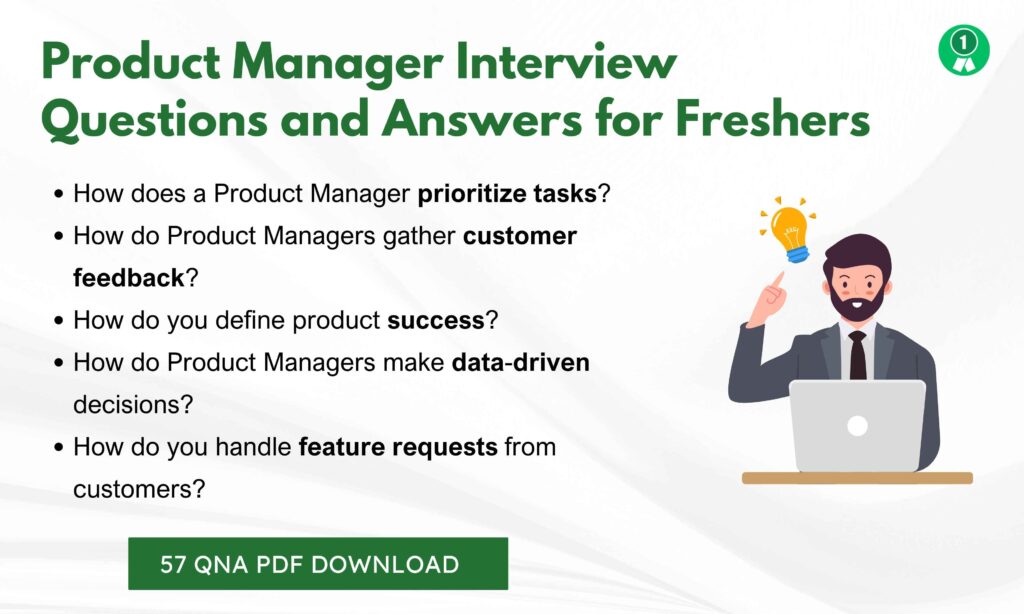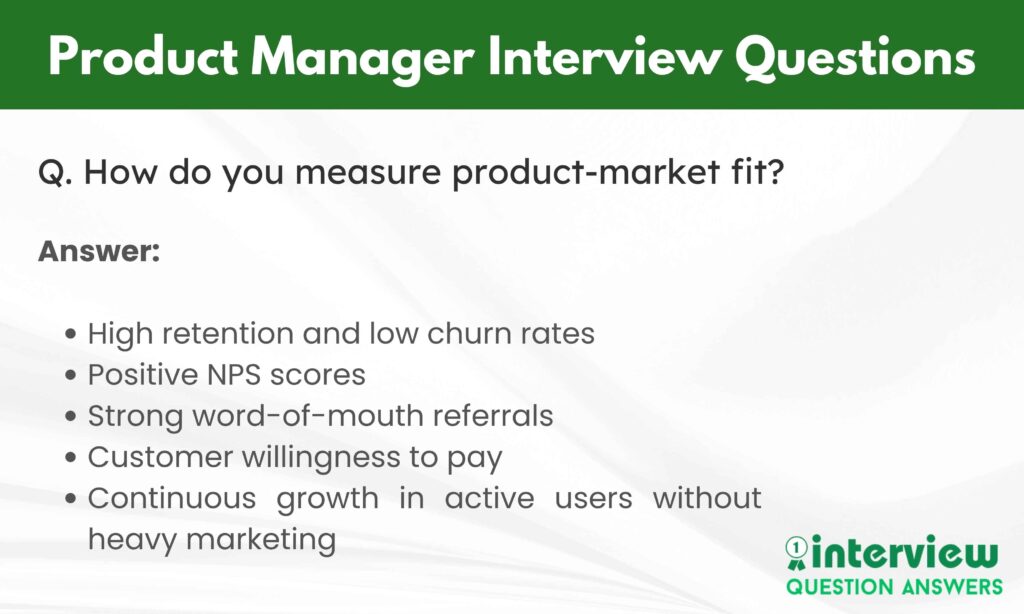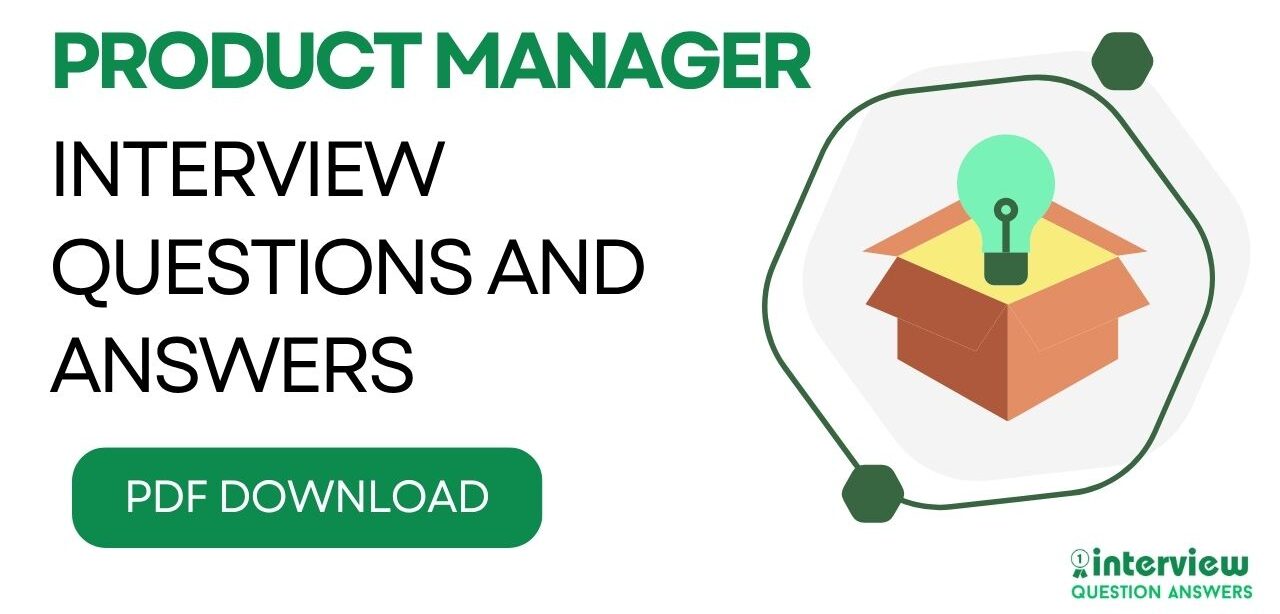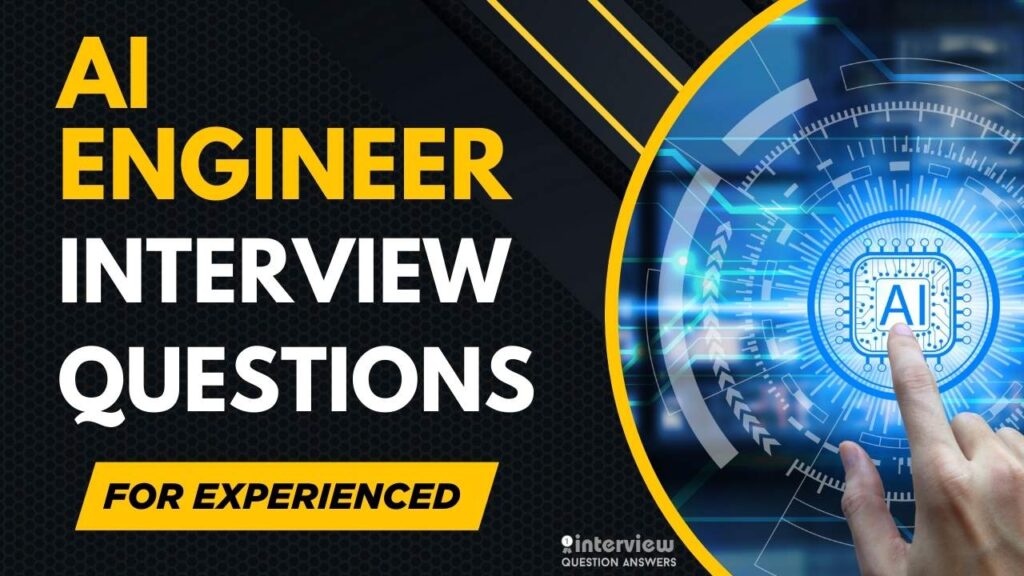Product Managers guide products from planning to launch, collaborating with engineering, marketing, and sales teams to drive business growth through successful product development.
The guide includes Interview questions in wide range, covering basic fundamentals for freshers, strategy and leadership for experienced and senior professionals, technical aspects like APIs and architecture, entry-level positions, and techncial and scenario based practice. Each section targets specific experience levels to ensure relevant preparation.
Table of Contents
Product Manager Interview Questions and Answers for Freshers
Lets start with basic fundamental based questions with sample answers.
Que 1. What is the role of a Product Manager?
Answer:
A Product Manager (PM) is responsible for planning, developing, and delivering products that meet customer needs and business goals. They work with cross-functional teams like engineering, marketing, and sales to define product strategy and ensure successful product delivery.
Que 2. How does a Product Manager prioritize tasks?
Answer:
Product Managers prioritize tasks using techniques like:
- MoSCoW method (Must have, Should have, Could have, Won’t have)
- RICE scoring (Reach, Impact, Confidence, Effort)
- Value vs. Effort Matrix
These help them decide what features or tasks should be worked on first based on business impact.
Que 3. What are some key skills required for a Product Manager role?
Answer:
- Strong communication and leadership skills
- Business understanding and market research abilities
- Problem-solving and analytical thinking
- Basic technical knowledge (for tech products)
- Customer-focused mindset
Que 4. How do Product Managers gather customer feedback?
Answer:
PMs collect feedback through:
- User interviews and surveys
- Customer support tickets
- Social media and online reviews
- Product usage data and analytics
- Beta testing programs
Que 5. What is a product roadmap?
Answer:
A product roadmap is a visual summary showing the plan for a product over time. It highlights major features, goals, and timelines, helping teams understand the product’s direction and align their work accordingly.
Que 6. How do you define product success?
Answer:
Product success is measured using key metrics like:
- Customer satisfaction and retention
- User engagement and adoption rates
- Revenue growth or profitability
- Achievement of business objectives
- Customer feedback and NPS (Net Promoter Score)
Que 7. What’s the difference between Agile and Waterfall methodologies?
Answer:
- Agile: Iterative development with frequent releases, constant feedback, and flexibility.
- Waterfall: Linear and sequential approach where each phase is completed before moving to the next.
Most modern Product Managers prefer Agile for its adaptability.
Que 8. How do you collaborate with engineering teams?
Answer:
PMs work with engineers by:
- Writing clear user stories and requirements
- Prioritizing work in sprints
- Participating in stand-ups and backlog grooming
- Clarifying doubts and removing roadblocks
- Ensuring technical feasibility is considered early
Que 9. What is MVP (Minimum Viable Product)?
Answer:
An MVP is the simplest version of a product that can be released to users to validate assumptions and gather feedback. It contains only the core features necessary to solve the primary user problem.
Que 10. How do you handle conflicting stakeholder requests?
Answer:
- Prioritize based on business value and user needs
- Use data to support decisions
- Communicate trade-offs transparently
- Align requests with the product vision and roadmap
Que 11. What is a product backlog?
Answer:
A product backlog is a prioritized list of features, enhancements, and bug fixes required for a product. It serves as a to-do list for the development team, managed by the Product Manager or Product Owner.
Que 12. How do you ensure the team stays aligned with product goals?
Answer:
- Communicate the product vision regularly
- Share and update the roadmap
- Set clear OKRs (Objectives and Key Results)
- Conduct regular team check-ins and demos
Que 13. How do Product Managers make data-driven decisions?
Answer:
PMs analyze:
- Usage data (e.g., Google Analytics)
- Conversion rates and funnel analysis
- A/B testing results
- Customer surveys and interviews
- Business KPIs like revenue and churn rates
Que 14. How do you handle missed deadlines?
Answer:
- Analyze why the deadline was missed
- Reassess priorities and resources
- Communicate delays transparently to stakeholders
- Adjust future planning to avoid similar issues
Que 15. What tools do Product Managers commonly use?
Answer:
| Tool Category | Common Tools | Purpose |
|---|---|---|
| Task Management | Jira, Trello | Managing tasks and workflows |
| Design/Wireframing | Figma, Sketch | Creating wireframes and prototypes |
| Data Analysis | Google Analytics, Mixpanel | Analyzing user behavior and metrics |
| Communication | Slack, Microsoft Teams | Team communication and collaboration |
| Documentation | Notion, Confluence | Project and knowledge documentation |
Que 16. How does a Product Manager contribute to user experience (UX)?
Answer:
PMs work with UX designers to:
- Define customer personas
- Set usability goals
- Review prototypes and wireframes
- Collect and analyze user feedback
- Ensure the final product is intuitive and user-friendly
Que 17. How do you handle feature requests from customers?
Answer:
- Evaluate requests against product goals and priorities
- Validate requests through data and customer interviews
- Add feasible and valuable features to the backlog
- Communicate clearly to customers about accepted and rejected requests
Que 18. What’s the difference between a Product Owner and a Product Manager?
Answer:
- Product Owner focuses more on managing the development team and sprint backlog.
- Product Manager handles broader responsibilities like product strategy, market research, and stakeholder communication.
Both roles often overlap in Agile environments.
Que 19. How do you stay updated on market trends?
Answer:
- Follow industry blogs and news sources
- Attend webinars, conferences, and meetups
- Network with other professionals
- Conduct competitor analysis regularly
- Subscribe to newsletters and podcasts
Que 20. How do you handle failure or a product that didn’t meet its goals?
Answer:
- Analyze what went wrong using post-mortems
- Gather customer feedback to identify missing needs
- Learn from mistakes and document lessons
- Adjust the roadmap and strategies based on findings
- Maintain team morale and refocus on new priorities
Que 21. How do you conduct a user interview as a Product Manager?
Answer:
Plan the interview by defining objectives and preparing open-ended questions to understand user needs and pain points. Conduct sessions in a neutral environment, listen actively, and avoid leading questions. Document insights and share with the team to inform product decisions.
Que 22. What is the purpose of a customer journey map in product management?
Answer:
A customer journey map visualizes the user’s experience with a product, identifying touchpoints, emotions, and pain points across stages. It helps prioritize features and improve UX by aligning product development with user expectations.
Que 23. How do you use wireframes in the product development process?
Answer:
Wireframes outline the basic structure and layout of a product’s interface. As a PM, collaborate with UX designers to create low-fidelity wireframes, gather feedback from stakeholders, and iterate before development to ensure alignment on functionality and design.
Que 24. What is the role of user stories in Agile product management?
Answer:
User stories define features from the user’s perspective in the format “As a [user], I want [function] so that [benefit].” They guide development, keep the team user-focused, and are prioritized in the product backlog for sprint planning.
Que 25. How do you collaborate with a UX designer as a Product Manager?
Answer:
Work closely with UX designers to define user flows, review wireframes, and validate designs through user testing. Provide clear requirements, share customer feedback, and align on product goals to ensure a seamless user experience.
Que 26. What is a sprint retrospective, and how do you contribute to it?
Answer:
A sprint retrospective is a meeting to reflect on what went well, what didn’t, and how to improve after a sprint. As a PM, contribute by sharing observations on process efficiency, feature delivery, and stakeholder feedback, suggesting actionable improvements.
Que 27. How do you assess the feasibility of a new feature request?
Answer:
Evaluate the feature against user needs, business goals, and technical constraints. Consult with engineering and design teams, estimate effort using story points, and prioritize based on impact and alignment with the product roadmap.
Que 28. What is the importance of a product vision statement?
Answer:
A product vision statement articulates the long-term purpose and goals of the product. It guides decision-making, aligns stakeholders, and inspires the team to focus on delivering value that supports the overarching mission.
Que 29. How do you handle scope creep during a product development cycle?
Answer:
Prevent scope creep by defining clear requirements in the PRD and maintaining a prioritized backlog. Communicate with stakeholders to assess new requests, defer non-critical ones to future sprints, and ensure alignment with project goals.
Que 30. What is the role of beta testing in product management?
Answer:
Beta testing involves releasing a product to a limited audience to gather feedback before full launch. As a PM, define test objectives, select testers, collect data on usability and bugs, and iterate on the product to ensure quality.

Also check: Product manager Interview Questions for Freshers
Product Manager Interview Questions and Answers for Experienced Senior
Que 31. How do you define and track KPIs for product success?
Answer:
KPIs (Key Performance Indicators) for products may include:
- Monthly Active Users (MAU)
- Customer Retention Rate
- Net Promoter Score (NPS)
- Average Revenue Per User (ARPU)
- Conversion Rates
PMs regularly monitor these metrics to evaluate product performance and identify improvement areas.
Que 32. What is a Product Requirements Document (PRD)?
Answer:
A PRD outlines the product’s features, functionality, and technical requirements. It serves as a guide for development and design teams, ensuring alignment across stakeholders on what needs to be built and why.
Que 33. How do you handle a situation where the product vision changes?
Answer:
- Reassess current plans and priorities
- Update stakeholders transparently
- Adjust the roadmap and backlog
- Align cross-functional teams with the new vision
- Revalidate features and goals accordingly
Que 34. What is the role of A/B testing in product management?
Answer:
A/B testing allows PMs to compare two versions of a feature or product change to determine which performs better using actual user data, supporting data-driven decision-making.
Que 35. How do you balance short-term goals with long-term product vision?
Answer:
- Use a clear roadmap separating short-term deliverables from long-term milestones
- Communicate trade-offs with stakeholders
- Prioritize tasks that serve both immediate needs and future scalability
- Review priorities regularly
Que 36. How do you manage cross-functional team conflicts?
Answer:
- Listen to both sides objectively
- Focus discussions on data and business goals
- Mediate solutions that address team concerns without losing focus on priorities
- Escalate only when necessary
Que 37. How do you validate a new product idea?
Answer:
- Conduct market and competitor research
- Create an MVP to test assumptions
- Gather user feedback through interviews or beta testing
- Use surveys and analytics to measure interest
- Evaluate financial viability
Que 38. What is the purpose of a Go-to-Market (GTM) strategy?
Answer:
A GTM strategy outlines how a product will be introduced to the market, including target audience, marketing plan, sales strategy, pricing, and support plans, ensuring a successful product launch.
Que 39. How do you ensure stakeholder alignment?
Answer:
- Communicate clearly and regularly
- Use dashboards and reports to show progress
- Involve stakeholders early in planning
- Manage expectations transparently
- Conduct regular reviews and feedback sessions
Que 40. What’s your approach to backlog grooming?
Answer:
- Regularly review and update the backlog
- Prioritize based on business value and urgency
- Clarify and refine user stories with the development team
- Remove outdated or irrelevant items
Que 41. How do you conduct competitive analysis?
Answer:
- Identify key competitors
- Analyze their product features, pricing, market positioning
- Track customer reviews and feedback
- Evaluate their strengths and weaknesses
- Use findings to shape your product strategy
Que 42. Explain the Lean Startup methodology.
Answer:
Lean Startup focuses on building MVPs, testing assumptions quickly, and iterating based on feedback to minimize wasted effort and accelerate product-market fit.
Que 43. How do you manage product risks?
Answer:
- Identify potential risks early
- Assess their impact and likelihood
- Create mitigation plans
- Monitor risks continuously during the project
- Communicate risks to stakeholders proactively
Que 44. What’s the role of empathy in product management?
Answer:
Empathy helps PMs understand customer pain points, enabling them to create products that truly address user needs. It also improves collaboration across teams by fostering trust and understanding.
Que 45. How do you measure user engagement?
Answer:
- Daily or Monthly Active Users (DAU/MAU)
- Session length and frequency
- Retention and churn rates
- Feature adoption rates
- User feedback and satisfaction scores
Que 46. How do you approach product scalability challenges?
Answer:
- Plan for growth from the start
- Ensure technical architecture can handle increased load
- Optimize operational processes
- Use modular and flexible frameworks
- Collaborate with engineering early in scaling discussions
Que 47. What methods do you use for user segmentation?
Answer:
| Segmentation Method | Description |
|---|---|
| Demographic Data | Age, location, income, gender |
| Behavioral Data | Usage patterns, purchase history, engagement levels |
| Psychographic Data | Interests, lifestyle, values |
| Purpose | To deliver personalized features and targeted marketing |
Que 48. How do you prioritize technical debt?
Answer:
- Balance between building new features and addressing technical debt
- Evaluate the impact of debt on product scalability and performance
- Collaborate with engineers to identify critical issues
- Schedule refactoring tasks in sprints
Que 49. What is OKR and how do you use it?
Answer:
OKR (Objectives and Key Results) is a goal-setting framework used to align teams around measurable objectives. PMs use OKRs to track progress and ensure the product team focuses on high-impact goals.
Que 50. How do you measure product-market fit?
Answer:
- High retention and low churn rates
- Positive NPS scores
- Strong word-of-mouth referrals
- Customer willingness to pay
- Continuous growth in active users without heavy marketing
Que 51. How do you align product strategy with evolving business objectives in a fast-paced market?
Answer:
Align product strategy by regularly reviewing company goals with leadership and mapping them to the product roadmap. Conduct quarterly strategy sessions, use OKRs to track alignment, and pivot features based on market feedback and competitive analysis, ensuring agility while maintaining long-term vision.
Que 52. How do you manage a product portfolio across multiple teams and markets?
Answer:
Centralize portfolio oversight with a unified roadmap, prioritizing features based on ROI and market needs. Use tools like Jira for cross-team coordination, establish clear communication channels, and delegate execution to team leads while monitoring KPIs to ensure consistency and scalability.
Que 53. How do you approach sunsetting a product or feature without alienating users?
Answer:
Develop a phased sunset plan: notify users early, provide migration paths to alternatives, and offer support during transition. Analyze usage data to target communications, gather feedback to address concerns, and maintain transparency to preserve trust and brand loyalty.
Que 54. How do you leverage advanced analytics to drive product decisions?
Answer:
Integrate tools like Amplitude or Mixpanel to track user behavior and product metrics. Define key metrics (e.g., retention, conversion), conduct cohort analysis, and use predictive models to identify trends, informing feature prioritization and optimization strategies.
Que 55. How do you navigate conflicts between technical feasibility and customer demands?
Answer:
Facilitate discussions between engineering and customer-facing teams to assess trade-offs. Use data-driven insights to quantify customer impact, propose phased rollouts or MVPs, and negotiate solutions that balance technical constraints with user value, ensuring clear stakeholder communication.
Que 56. How do you scale a product globally while addressing regional compliance requirements?
Answer:
Research regional regulations (e.g., GDPR, CCPA) and collaborate with legal teams to ensure compliance. Localize features, UI, and content using customer feedback, and implement modular architecture to support region-specific customizations while maintaining a unified product core.
Que 57. How do you mentor junior product managers to build a high-performing team?
Answer:
Provide structured guidance through regular 1:1s, set clear expectations, and assign stretch projects to build skills. Share frameworks like RACI or Jobs-to-be-Done, encourage data-driven decision-making, and foster a culture of feedback and continuous learning.
Que 58. How do you drive adoption of a new product in a saturated market?
Answer:
Identify unique value propositions through competitive analysis and customer interviews. Develop targeted GTM strategies, leverage early adopters for advocacy, and use A/B testing to refine messaging and features, ensuring differentiation and measurable uptake.
Que 59. How do you manage stakeholder expectations during a major product pivot?
Answer:
Communicate the pivot rationale using data (e.g., market shifts, user feedback). Present a revised roadmap with clear milestones, manage expectations through regular updates, and involve stakeholders in validation to secure buy-in and minimize resistance.
Que 60. How do you integrate AI or emerging technologies into an existing product strategy?
Answer:
Evaluate AI’s potential to enhance user value (e.g., personalization, automation). Pilot small-scale implementations, measure impact with KPIs, and collaborate with data science teams to integrate models, ensuring scalability and alignment with product goals.

Also check: Technical Project Manager Interview Questions and Answers
Technical Product Manager Interview Questions and Answers
Que 61. What is the role of a Technical Product Manager (TPM)?
Answer:
A Technical Product Manager focuses on both the technical and business aspects of product development. They work closely with engineering teams, understand system architecture, prioritize technical tasks, and ensure that product decisions align with both customer needs and technical feasibility.
Que 62. How does a TPM work differently from a non-technical Product Manager?
Answer:
While traditional PMs focus more on customer needs, market research, and business strategy, TPMs also:
- Understand technical system design and constraints
- Communicate effectively with engineers using technical language
- Prioritize technical debt, scalability, and architectural decisions
Que 63. How do you handle API development projects as a Technical Product Manager?
Answer:
- Define clear API use cases and requirements
- Work with engineering to design scalable APIs
- Document endpoints, request/response formats, and error handling
- Coordinate testing, versioning, and release plans
- Gather feedback from API consumers for improvements
Que 64. What technical skills are essential for a TPM role?
Answer:
- Basic programming knowledge (e.g., Python, Java, or SQL)
- Understanding of cloud architecture (AWS, Azure, GCP)
- Familiarity with CI/CD pipelines
- API design and documentation
- Database fundamentals
- System scalability and security principles
Que 65. How do you balance technical debt against feature development?
Answer:
- Collaborate with engineers to identify critical debt
- Quantify technical debt impact (performance, scalability, security)
- Communicate risks to stakeholders
- Include debt resolution tasks in regular sprints
- Focus on long-term sustainability over short-term feature delivery
Que 66. How do you approach backlog prioritization from a technical perspective?
Answer:
- Include technical stories (debt, refactoring) alongside features
- Use scoring models (RICE, Value vs. Effort) considering both business and technical impact
- Discuss priorities in regular grooming sessions with engineers
- Balance customer-facing features with architectural improvements
Que 67. How do you handle system scalability challenges in your roadmap?
Answer:
- Identify scalability bottlenecks early via architecture reviews
- Prioritize infrastructure upgrades when needed
- Work with DevOps to plan auto-scaling and load balancing
- Include performance testing in release cycles
- Allocate roadmap time for optimization projects
Que 68. How do you document technical requirements for your teams?
Answer:
- Use clear technical specifications
- Create sequence diagrams, data flow diagrams, and API documentation
- Write user stories with acceptance criteria that address technical constraints
- Use tools like Confluence, Swagger, or markdown files in repositories
Que 69. How do you communicate complex technical concepts to non-technical stakeholders?
Answer:
- Simplify without oversimplifying
- Use analogies and visual aids (charts, diagrams)
- Focus on business impact rather than technical details
- Translate risks, trade-offs, and timelines into clear, actionable insights
Que 70. How do you prioritize technical infrastructure improvements versus customer-facing features as a Technical Product Manager?
Answer:
Balance infrastructure and features by assessing impact on scalability, reliability, and user value. Use a weighted scoring model (e.g., impact, effort, risk) to prioritize. Engage with engineering to quantify technical debt costs and align with customer feedback to ensure features drive revenue or retention, presenting trade-offs to stakeholders for consensus.
Que 71. How do you collaborate with engineering teams to define technical requirements for a new API?
Answer:
Work with engineers to define API objectives, endpoints, and data models, using tools like Swagger for documentation. Gather input from stakeholders on use cases, ensure RESTful design principles, and validate scalability and security requirements (e.g., rate limiting, authentication) before finalizing the PRD.
Que 72. How do you assess the feasibility of integrating a third-party API into your product?
Answer:
Evaluate the API’s documentation, reliability, and rate limits. Conduct a proof-of-concept to test integration, latency, and error handling. Assess vendor SLAs, security compliance (e.g., OAuth), and costs, then align with business goals to confirm strategic fit and long-term viability.
Que 73. How do you handle a situation where a technical dependency delays a product launch?
Answer:
Identify the root cause with engineering, explore workarounds (e.g., mocked data, phased rollout), and adjust the roadmap. Communicate delays transparently to stakeholders, proposing mitigation like prioritizing alternative features, and set up monitoring to prevent future dependency bottlenecks.
Que 74. What is your approach to managing technical debt in a product roadmap?
Answer:
Catalog technical debt with engineering (e.g., outdated libraries, database bottlenecks) and prioritize based on risk and impact. Allocate 10-20% of sprint capacity for debt reduction, integrate fixes into feature development, and justify to stakeholders using metrics like system downtime or maintenance costs.
Que 75. How do you ensure a product’s architecture supports future scalability?
Answer:
Collaborate with architects to design modular, microservices-based systems. Assess load projections, implement caching (e.g., Redis), and plan for horizontal scaling. Validate with stress tests and monitor metrics like response time to ensure the architecture supports growth.
Que 76. How do you bridge the gap between technical teams and non-technical stakeholders?
Answer:
Translate technical concepts into business value (e.g., “faster APIs improve user retention”). Use visual aids like diagrams and shared tools (e.g., Confluence) to align teams. Facilitate regular syncs to clarify requirements and ensure mutual understanding of priorities.
Que 77. How do you validate the performance of a new backend system before launch?
Answer:
Define performance metrics (e.g., latency, throughput) with engineering. Conduct load testing using tools like JMeter, monitor with observability platforms (e.g., New Relic), and simulate edge cases. Iterate based on results and ensure SLAs meet user expectations before deployment.
Que 78. How do you manage the lifecycle of a deprecated feature in a technical product?
Answer:
Plan deprecation by notifying users, providing migration guides, and maintaining backward compatibility temporarily. Work with engineering to monitor usage, phase out via API versioning or feature flags, and update documentation to reflect changes, minimizing disruption.
Que 79. How do you incorporate security requirements into a product’s technical roadmap?
Answer:
Collaborate with security teams to identify risks (e.g., OWASP Top 10). Prioritize features like encryption, SSO, or input validation in the PRD. Conduct regular audits, integrate security testing in CI/CD, and ensure compliance with standards like GDPR or SOC 2.
Que 80. How do you approach building a data-driven product feature using machine learning?
Answer:
Define the ML feature’s goal (e.g., churn prediction) and work with data scientists to select models and data sources. Specify data pipelines, ensure data quality, and integrate with the product via APIs. Pilot the feature, monitor accuracy metrics, and iterate based on user feedback.

Associate Product Manager Interview Questions and Answers
Que 81. How do you prioritize tasks as an APM?
Answer:
- Focus on tasks with the highest impact
- Use guidance from senior PMs and roadmaps
- Apply simple methods like Value vs. Effort or MoSCoW
- Regularly update priorities based on stakeholder inputs
Que 82. How do you handle customer feedback as an APM?
Answer:
- Collect feedback from surveys, support tickets, and interviews
- Analyze common themes or pain points
- Summarize insights for senior PMs
- Suggest improvements or features based on customer needs
Que 83. What tools do APMs typically work with?
Answer:
- Jira, Trello for task management
- Google Analytics, Mixpanel for usage data
- Figma or Miro for wireframing and collaboration
- Slack, Notion for communication and documentation
- Spreadsheets for simple analysis
Que 84. How do you support sprint planning as an APM?
Answer:
- Help write user stories and acceptance criteria
- Prioritize backlog items with the senior PM
- Facilitate grooming sessions
- Track progress during sprints and assist in resolving blockers
Que 85. How do you learn about customer needs in an entry-level role?
Answer:
- Conduct or assist in customer interviews
- Review customer support interactions
- Analyze product usage data
- Participate in user testing and feedback sessions
Que 86. What skills are most important for an APM?
Answer:
- Communication and teamwork
- Analytical thinking and problem-solving
- Basic project management
- Customer empathy
- Willingness to learn technical and business concepts
Que 87. How do you handle pressure in a product team?
Answer:
- Stay organized using task trackers
- Communicate openly with team members and managers
- Break work into smaller, manageable steps
- Focus on solving problems calmly and learning from challenges
Que 88. What is the role of an Associate Product Manager (APM)?
Answer:
An Associate Product Manager assists senior product managers with research, data analysis, documentation, feature prioritization, and cross-team coordination. APMs help drive small projects while learning core product management responsibilities.
Que 89. How do you assist in creating a product requirements document (PRD) as an Associate Product Manager?
Answer:
Support the PRD creation by gathering stakeholder requirements, documenting user stories, and defining acceptance criteria. Collaborate with senior PMs to outline feature scope, technical constraints, and success metrics, using tools like Confluence to ensure clarity and alignment.
Que 90. What steps would you take to learn about a new product’s target audience?
Answer:
Conduct user interviews, analyze customer feedback through surveys, and review usage data in analytics tools (e.g., Google Analytics). Shadow senior PMs during research, study market trends, and create user personas to understand audience needs and behaviors.
Que 91. How do you contribute to sprint planning as an Associate Product Manager?
Answer:
Assist in prioritizing backlog items, refining user stories, and estimating effort with developers. Attend sprint planning meetings, clarify requirements, and ensure tasks align with the product roadmap, using tools like Jira to track progress.
Que 92. How do you handle a situation where a stakeholder requests a feature that conflicts with the product roadmap?
Answer:
Listen to the stakeholder’s rationale, assess the feature’s impact, and discuss trade-offs with the senior PM. Propose alternatives or deferral to a later sprint, documenting the decision to maintain transparency and alignment with roadmap priorities.
Que 93. What is your approach to tracking and reporting progress on product tasks?
Answer:
Use project management tools (e.g., Asana, Trello) to monitor task status and deadlines. Provide regular updates in team meetings, highlight blockers, and share progress against KPIs in reports to keep stakeholders informed and aligned.
Que 94. How do you support user testing for a new feature as an Associate Product Manager?
Answer:
Help organize user testing sessions by recruiting participants, preparing test scripts, and setting up tools like UserTesting. Collect feedback, summarize findings, and share actionable insights with the team to refine the feature before launch.
Que 95. How do you learn from customer feedback to improve a product?
Answer:
Review feedback from surveys, support tickets, and social media. Categorize insights into usability, functionality, or performance issues, prioritize actionable items, and propose improvements to the senior PM for backlog inclusion.
Que 96. What role does an Associate Product Manager play in a product launch?
Answer:
Support launch by coordinating with marketing for GTM plans, preparing user guides, and ensuring documentation is complete. Assist in monitoring post-launch metrics and addressing immediate issues to ensure a smooth rollout.
Que 97. How do you stay organized while managing multiple tasks in a fast-paced product team?
Answer:
Use tools like Notion or Trello to prioritize and track tasks. Break work into daily goals, maintain a shared team calendar, and communicate regularly with the team to stay aligned and manage workload effectively.
Que 98. How do you collaborate with customer support teams to address user issues?
Answer:
Engage with support teams to understand common user complaints, analyze ticket data for patterns, and propose product fixes. Attend support syncs to share updates and ensure user issues inform future iterations.
Que 99. What is your approach to learning about a new product’s technical architecture?
Answer:
Study documentation, attend technical syncs with engineering, and ask targeted questions about the system’s components and data flows. Use resources like architecture diagrams and collaborate with senior PMs to grasp key technical concepts.
Que 100. How do you contribute to competitive analysis as an Associate Product Manager?
Answer:
Research competitors’ features, pricing, and user reviews using tools like G2 or Crunchbase. Summarize findings in a comparison matrix, highlight gaps or opportunities, and share with the team to inform product positioning and strategy.
Product Manager Interview Questions PDF
This interview questions guide is also available as a PDF for convenient offline study, making it easy to prepare anywhere and anytime for your product management interviews.
FAQs: Product Manager Interview Questions
What is the role of a Product Manager?
A Product Manager (PM) acts as a bridge between business goals, customer needs, and technical teams. They define product strategies, create roadmaps, prioritize features, and ensure successful product delivery. Their focus is on creating valuable products that meet both market demands and business objectives.
What challenges do candidates face during a Product Manager interview?
Product Manager interviews can be challenging due to their mix of technical, business, and behavioral questions. Candidates often struggle with case studies, product design tasks, and strategic thinking exercises. Clear communication and structured problem-solving are essential to succeed.
What are common job challenges for a Product Manager?
In the role, PMs commonly face conflicting stakeholder priorities, tight deadlines, and resource constraints. Balancing customer needs with business goals, managing cross-functional teams, and making data-driven decisions while handling uncertainty are ongoing challenges.
How important is technical knowledge for a Product Manager?
While not mandatory, technical knowledge helps PMs communicate effectively with engineering teams and understand the feasibility of solutions. Many companies prefer PMs with a basic understanding of software development, APIs, and data analysis to make informed product decisions.
What is the average salary of a Product Manager in the USA?
In the USA, Product Managers typically earn between $90,000 to $140,000 per year, depending on experience, location, and industry. Senior Product Managers or those working in top tech firms can earn upwards of $160,000 annually, excluding bonuses and stock options.
Which top companies hire Product Managers?
Leading companies hiring Product Managers include Google, Amazon, Microsoft, Apple, Meta (Facebook), Salesforce, Adobe, and startups like Stripe, Shopify, and Airbnb. These organizations value strong analytical skills, customer-focused thinking, and the ability to lead cross-functional teams.
Why is interview preparation crucial for Product Manager roles?
Proper interview preparation helps candidates showcase their strategic thinking, product sense, and leadership abilities effectively. Practicing scenario-based questions, understanding business models, and refining communication skills increase the chances of standing out during competitive PM interviews.
Conclusion
Preparing for a Product Manager interview requires both business knowledge and problem solving skills. This guide covers practical and commonly asked questions for different PM roles, including Technical Product Managers, Associate Product Managers, and professionals with varying levels of experience.
Also keep remember to download the Product Manager Interview Questions and Answers PDF for offline practice. Review, learn, and practice to boost your confidence and get ready to excel in your next Product Manager interview.
Also Check:







